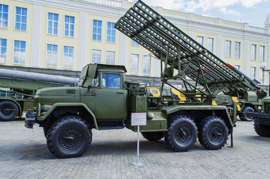
Barrelless system of field rocket artillery “Katyusha” during the Second World War.
In Russia, work is underway to create a fully automated (robotic) multiple launch rocket system (MLRS), according to the American edition of The National Interest. According to the author of the article, we are talking about a remotely controlled robotic complex with automated control of the entire set of ammunition included in the ammunition load of such an installation. The author believes that the Russian military wants to get an “unmanned” tactical weapons system capable of destroying enemy targets, equipment and manpower with high accuracy at a great distance. AiF.ru figured out what frightened foreign military journalists so much.
The article reports that Russian designers intend to create a crewless vehicle with a multiple launch rocket launcher located on it, capable of independently reaching the intended position and firing guided ammunition from it. The rocket launcher will be able to independently hit targets and will be capable of destroying an entire settlement with one salvo. She has already been named “Robokatyusha”.
Earlier, the general director of the leading Russian enterprise-developer of rocket artillery – NPO Splav named after Ganichev (part of the Tekhmash concern of Rostec), Alexander Smirnov, said that multiple launch rocket systems developed in Russia, such as Tornado-G and Tornado-S “, Have components that can become the basis for a promising robotized MLRS. Now the means for their automation are minimal.
Currently, the available means allow you to automate the preparation process, control the guidance of the launch package and the shooting itself, as well as perform automatic topographic positioning and orientation of the combat vehicle on the ground. And also remotely enter flight mission data into fuses and launch projectiles without having to leave the cockpit.
Yet it is not entirely clear what is meant by automation. Modern weapons, such as tanks and artillery, often have some degree of automation, such as automatic weapons to charge weapons to increase the rate of fire or automatic countermeasures to stop oncoming missiles. However, offering a fully autonomous multiple launch rocket system takes automation to a much higher level. A real MLRS must be an unmanned truck capable of overcoming obstacles (and doing so under fire). He must be able to operate in formation – for example, convoys – with friendly forces, without colliding with other vehicles or running into people. In turn, this requires the use of sophisticated artificial intelligence and comprehensive situational awareness. It also requires a reliable communications system because the multiple launch rocket system must know its exact location and the location of the enemy.
The biggest problem, according to the foreign journalist, is command and control. Presumably, an automatic rocket launcher will not be able to fire without the participation of a person in the circuit to issue the command. If this is the case, then Robokatyusha will not have enough human mental flexibility to respond to emergencies, such as self-defense when attacking or providing fire support to friendly troops, even when there is no communication. In other words, Russia would have to solve all the problems that Google and Tesla faced with self-driving cars if there were a ton of explosives in those cars.
But then again, an unmanned vehicle that has a software glitch can run over an unfortunate pedestrian or cyclist. An artificially intelligent multiple launch rocket launcher can destroy an entire village, or even a small city, in one salvo.

